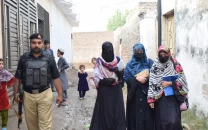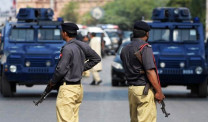Analysis: How to buttress security of airports
Karachi airport attack exposed loopholes, which in turn call for improvement in standard operating procedures.

Armoured vehicles stand guard at Karachi airport. PHOTO: PPI
The Airports Security Force’s (ASF) response to quell the terrorist attack on Karachi’s Jinnah International Airport within hours must be appreciated and those who laid down their lives to thwart the evil designs must be saluted. However, the bitter reality of a serious security breach resulting in negative impact for the country internationally, given the precarious security environment within Pakistan, cannot be overlooked.
The attack exposed visible loopholes, which in turn call for improvement in the standard operating procedures to pre-empt any such incidents in the future.
Incompetence of the Civil Aviation Authority (CAA) and its management to tackle such disasters stands exposed. Unfortunately, CAA’s vast revenue generation has fallen prey to the greed of corrupt political appointees and retired officers, instead of investing in building a credible infrastructure to promptly handle any emergency with state-of-the-art firefighting capacity and equipment to handle any incident by qualified and trained manpower.
Also, visible was the lack of basic infrastructure and training by the city government to fight such disasters. The course of action by the security forces after the initial crackdown should have been to carry out a thorough search and rescue operation to locate victims and clear the airport and its periphery for hideouts of facilitators involved in execution of this attack, before flight operation was resumed.
But the director general of CAA Pakistan, the aviation secretary, and their immediate political boss adviser to the PM on aviation failed. Likewise, the ASF chief, entrusted with airport security also failed because he and his team could not visualise loopholes, such as the Fokker Gate or the Cargo Terminal Gate, which were poorly guarded.
This country faces a grave security crisis, and following the TTP’s attack at Fateh Jang in Rawalpindi, where five citizens were martyred, terrorists had openly declared war threatening to launch an offensive. All civil airports, especially Karachi’s International Airport were among their primary targets.
In every major accident, or hijacking, that has occurred since 1986 in the assault on PAN AM flight by the Abu Nidal Organisation, miscreants have entered the airport wearing uniforms. They have used entry points other than the main terminal, because entrances located next to Wide Body Hangar, Cargo Terminal, Catering Terminal, Private and Charter Airline terminals have always been poorly guarded, making it an ideal choice for nefarious activities, including smuggling.
Until the ‘80s there were hardly any residential housing societies, or commercial projects built on the northern periphery of Karachi airport. Thereafter, all sorts of construction has mushroomed and even the road next to CAA offices, which was closed, has been opened to public transport and localities such as Pehlwan Goth, notorious for being a sanctuary for criminals, allowed to grow without any check.
It is the responsibility of the civil aviation and security organisations to ensure that there exists a sterile zone, totally barricaded, with round-the-clock security surveillance not just at Karachi airport but at the country’s other major airports.
But, unfortunately, when commercial interest by the powerful real estate development nexus and CAA are allowed to override mandatory security requirements, terrorists and miscreants will continue to be facilitated, as has been done frequently in Pakistan.
With the availability of the fingerprint and iris scanning equipment and database with NADRA, the civil aviation needs to re-evaluate all its employees for mandatory security clearances without succumbing to any political pressure and providing waivers.
What matters now is the follow-up action that should be taken bearing in mind lessons from the attack. One only hopes that greed for real estate will be resisted in Islamabad where the new airport is being constructed and conflict of interest of those at the helm of affairs in the aviation ministry, with their known financial involvement in lucrative housing and construction business would not jeopardise yet another civil airport built from the taxpayers’ money.
Pakistan needs an effective security apparatus such as Homeland Security or Airline Security, totally independent of any political or bureaucratic influence, including the CAA and should be accountable only to the prime minister, working in close coordination with the National Security Adviser.
The national security adviser should ensure that all existing residential construction within at least 2,000 yards of airport fencing are dismantled, irrespective of who the beneficiaries are. Meanwhile, there should exist a one-mile sterile zone, free of any construction around airports that are being built and a five-mile restricted zone for the construction height limits of 25 feet above the runway level in approach or take path zone.
Published in The Express Tribune, June 13th, 2014.



















COMMENTS
Comments are moderated and generally will be posted if they are on-topic and not abusive.
For more information, please see our Comments FAQ